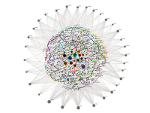 Outreach
Outreach
OUTREACH
Front dynamics and localized structures on nonlinear spatially extended systems focus of the article published by IFISC researchers in Physical Review Letters.
Damià Gomila, Pere Colet and Daniel Walgraef, researchers at IFISC, has published recently an article in Physical Review Letters which addresses some fundamental questions regarding the dynamics of asymmetric fronts and its interaction which can lead to the formation of localized structure. The Instituto de Física Interdisciplinar y Sistemas Complejos, IFISC, is a joint research institute of CSIC, the Spanish Research Council, and the Universitat de les Illes Balears in Palma de Mallorca, Spain.
Nonlinear systems can exhibit bistability, namely the system can adopt two different stable states under the same operating conditions. In sufficiently large spatially extended systems, parts of the system can be in one of the states and the other parts to the other, leading to the formation of fronts connecting the two different states. In this study we focus in the case in which the two states are equivalent and we derive a generic reduced model to explain the interaction of the fronts. In this situation the profile of the front can be symmetrical around its center (Ising fronts) or not (Bloch fronts). A solitary Ising front is stable while a solitary Bloch front moves in a given direction with a constant speed determined by its degree of asymmetry (also known as chirality). The reduced generic model developed in the article allows to understand how the tails in the profile of the front together with the chirality leads to a rich variety of behavior, such as the formation of static and oscillating localized structures and front collisions.
In the article "Theory for the spatio-temporal dynamics of domain walls close to a nonequilibrium Ising-Bloch transition", the IFISC rearchers show that this scenario is universal and applies to a large variety of systems ranging from chemical reactions to lásers.
Bibliographic Reference:
Gomila, Damià; Colet, Pere; Walgraef, Daniel. "Theory for the spatio-temporal dynamics of domain walls close to a nonequilibrium Ising-Bloch transition" Phys. Rev. Lett. 114, 084101 (2015) DOI:10.1103/PhysRevLett.114.084101
http://journals.aps.org/prl/abstract/10.1103/PhysRevLett.114.084101
![]()










